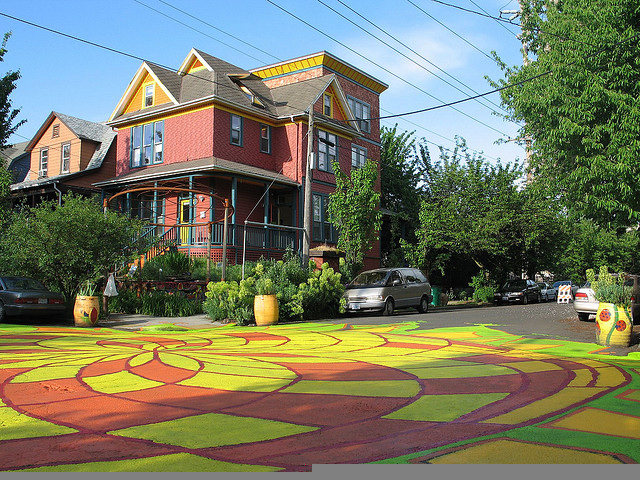 Sunnyside Piazza.Photo: Daniel Etra Cross-posted from Sightline Daily.
Sunnyside Piazza.Photo: Daniel Etra Cross-posted from Sightline Daily.
What if all it took to build better neighborhoods was a little paint?
Walking in southeast Portland, I once stumbled on a horizontal rendition of a sunflower, painted curb to curb on the intersection of Southeast 33rd and Yamhill. Sunnyside Piazza, it is called, which may seem a bit much for a splash of color on asphalt, but in person, it seemed fitting. This whimsical design, interrupting the functional but monotonous gray of Portland’s street grid, felt like a somewhere. It seemed like a place deserving a name. It even felt like a “piazza.”
That was in 2002. I later learned that the Sunnyside Piazza was the second painted public square in Portland, facilitated by the nonprofit City Repair Project. Now, dozens of painted plazas, dubbed Intersection Repairs, pepper the map not just of Portland but also of Los Angeles, New York, St. Paul, and Seattle.
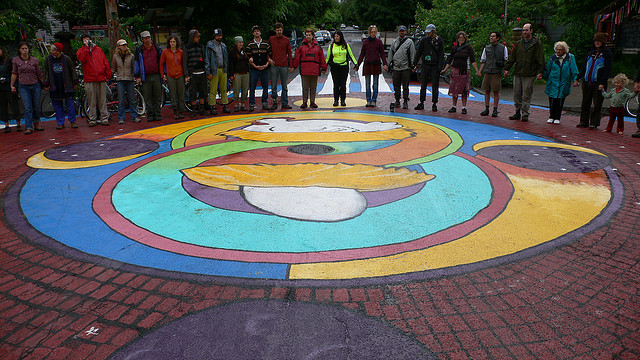 Share-It-Square.Photo: donkeycart It all started in the mid-1990s with Share-It-Square, in Portland’s Sellwood neighborhood, where architect and City Repair co-founder Mark Lakeman lives. After visiting villages in Central America where residents gather around common spaces, Lakeman decided to bring similar spaces to Portland. “Putting the public space back where it’s supposed to be may not sound like a huge change,” Lakeman says, “but it has a profound effect on the social culture … We know that Americans are more lonely and isolated than ever before, but we don’t realize that the absence of cohesion in American communities is totally related to the absence of places where people can actually build that.”
Share-It-Square.Photo: donkeycart It all started in the mid-1990s with Share-It-Square, in Portland’s Sellwood neighborhood, where architect and City Repair co-founder Mark Lakeman lives. After visiting villages in Central America where residents gather around common spaces, Lakeman decided to bring similar spaces to Portland. “Putting the public space back where it’s supposed to be may not sound like a huge change,” Lakeman says, “but it has a profound effect on the social culture … We know that Americans are more lonely and isolated than ever before, but we don’t realize that the absence of cohesion in American communities is totally related to the absence of places where people can actually build that.”
Looking at his own neighborhood, Lakeman decided to transform the intersection of Sherret and 9th from a car-dominant space to a public place (documented in this video). He thought this change fitting, as cultures throughout history have come together at crossroads. Of course, there was still the question of how to take an intersection — an endlessly repeated but utterly non-convivial fixture of the city’s street grid — and turn it into a place. Lakeman and his neighbors’ brilliance was in the simplicity of their brainstorm: paint a picture.
The Portland Department of Transportation (PDOT) was taken aback by the idea, however. One city official told Lakeman, “That’s public space. Nobody can use it.” The residents went guerrilla: They painted without permission.
PDOT was furious. Officials threatened to sandblast the design off the roadway. But the neighborhood gained political support from Councilmember Charlie Hales and Mayor Vera Katz. When the city surveyed the neighbors living near Share-It-Square, they found residents had positive perceptions of less crime, slower traffic, and increased neighborhood involvement. Seeing that the painted intersection hadn’t cost the government a dime, the politicians quickly moved to pass a city ordinance that allowed painted intersections throughout Portland.
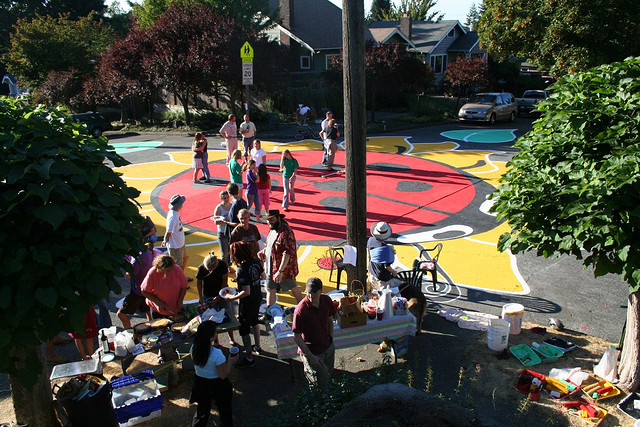 The Wallingford ladybug.Photo: bmarymanIntersection repairs are popping up in other cities, too. In Seattle, a City Repair chapter formed and facilitated several intersection painting projects, including a ladybug in the Wallingford neighborhood. Residents meet annually to repaint the mural and hold a block party. “Our goal is to cut down traffic and bring the community together and create a sense of neighborhood,” Eric Higbee, who led the ladybug painting, told the Seattle Times.
The Wallingford ladybug.Photo: bmarymanIntersection repairs are popping up in other cities, too. In Seattle, a City Repair chapter formed and facilitated several intersection painting projects, including a ladybug in the Wallingford neighborhood. Residents meet annually to repaint the mural and hold a block party. “Our goal is to cut down traffic and bring the community together and create a sense of neighborhood,” Eric Higbee, who led the ladybug painting, told the Seattle Times.
“It’s not about the paint,” says professor Jan Semenza, a professor of public health at Portland State University who lives near the Sunnyside Piazza and has researched intersection repairs. “It’s about neighbors creating something bigger than themselves.” As an everyday intersection becomes someplace special, residents begin to experience the value of community. Neighbors paint themselves out of a corner — of the intersection, of their individual homes — and into the middle of the street. By turning an intersection from a dividing line between neighbors into a gathering place, residents begin to solve the problems that plague neighborhoods and cities. Where isolation existed, they find community. Where cars dominated, they create a people place. With a little paint, neighbors are solving big problems.
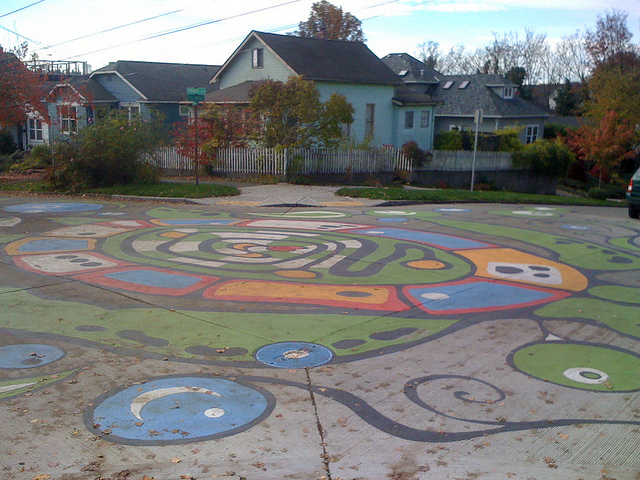 The Fremont Turtle.Photo: justsmartdesignWhile her parents initially thought of painting the street at 41st and Interlake Avenue North in Seattle’s Fremont neighborhood, 8-year-old Ella Sauer hatched the idea of making a turtle. The family then approached neighbor Bill Lindberg with the plan, and Lindberg helped bring residents together and work through the permitting process. The turtle cost a little more than $1,000, including Seattle Department of Transportation permits; the residents received a Neighborhood Matching Fund grant for half of the cost. Painting their street brought neighbors together in a way not typically possible during the daily routine.
The Fremont Turtle.Photo: justsmartdesignWhile her parents initially thought of painting the street at 41st and Interlake Avenue North in Seattle’s Fremont neighborhood, 8-year-old Ella Sauer hatched the idea of making a turtle. The family then approached neighbor Bill Lindberg with the plan, and Lindberg helped bring residents together and work through the permitting process. The turtle cost a little more than $1,000, including Seattle Department of Transportation permits; the residents received a Neighborhood Matching Fund grant for half of the cost. Painting their street brought neighbors together in a way not typically possible during the daily routine.
“This is the only way I’m able to meet my neighbors on a personal level,” said Kate Gengo, a four-year resident of the neighborhood.
The process of creating a public square empowers the residents and builds relationships, but it also leaves evidence on the ground that something is different in the neighborhood. “It sounds whimsical, but then you go walk around [the Intersection Repair] on a Saturday afternoon and you get it,” says supporter and former Portland city councilor Charlie Hales. Neighbors are talking, cars drive slower, and you can tell you are in a place. When people drive or walk through an Intersection Repair project, they are inspired to reshape their own neighborhoods. City Repair now has facilitated hundreds of community-building projects throughout Portland.
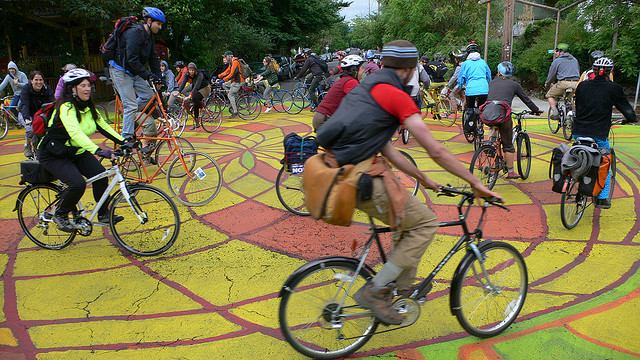 Sunnyside Piazza.Photo: donkeycartSemeza decided to turn his neighborhood into a laboratory. He had students canvass the Sunnyside neighborhood and also survey a similar neighborhood without an Intersection Repair. While there are not enough data to pinpoint the exact reasons, it appears that the Sunnyside Piazza neighbors considered themselves healthier (86 percent in excellent/very good general health compared to 70 percent), happier (57 percent felt “hardly ever depressed” versus 40 percent), and content with their neighborhood (65 percent said their neighborhood was “an excellent place to live” versus 35 percent). Also, police calls from the Sunnyside Piazza neighborhood decreased after the painting project.
Sunnyside Piazza.Photo: donkeycartSemeza decided to turn his neighborhood into a laboratory. He had students canvass the Sunnyside neighborhood and also survey a similar neighborhood without an Intersection Repair. While there are not enough data to pinpoint the exact reasons, it appears that the Sunnyside Piazza neighbors considered themselves healthier (86 percent in excellent/very good general health compared to 70 percent), happier (57 percent felt “hardly ever depressed” versus 40 percent), and content with their neighborhood (65 percent said their neighborhood was “an excellent place to live” versus 35 percent). Also, police calls from the Sunnyside Piazza neighborhood decreased after the painting project.
Near Share-It-Square, Mark Lakeman sees residents staying rooted in the community. “Americans move every four to seven years,” Lakeman says, “and that period of time is visibly lengthening right around that intersection because people want to live there. Families are clustering around it, having kids or bringing their kids, so there are more children and more shared childcare, and more adults interacting with kids on that street.”
Flying over cities, whether in an airplane or through Google Maps, streets and homes extend for miles, with little to distinguish them. But then you see some color: a painted intersection in a sea of roofs and concrete. These are villages within the city — where locals have come together and said this is a place. A painted intersection might seem trivial. It doesn’t cost much or last very long. But the important work is done behind the scenes. Residents join together. They fashion gathering spaces. And it all starts with some paint.
